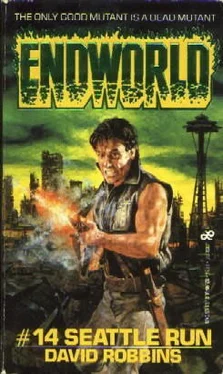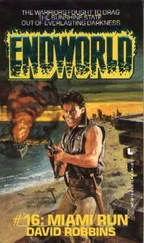David L. Robbins
SEATTLE RUN
High ground!
He needed high ground!
Captain Nathan Dale paused, perspiration beading his furrowed brow despite the chill January breeze, and scanned his surroundings for a suitable spot. His tattered uniform, now little more than strips of fabric clinging to his battered, pale skin, did nothing to ward off the cold. He surveyed the decayed, dilapidated structures nearest him, seeking somewhere high above the ruins of the city once known as Seattle to increase his chance of success.
Hurry! his mind shrieked.
Manta will be after you!
Dale’s naked feet padded on the cracked sidewalk as he hurried to the northwest, away from the Humarium, away from Pier 59. How far had he gone? he wondered.
Not far enough.
From the rear, perhaps 50 yards distant, wafted a loud, shrill whistle.
They were coming after him!
Frowning in frustration, Dale rounded a corner and glanced to the north. A cluster of buildings met his gaze, and even in the dark he recognized the configuration of the architectural marvel dominating the gloomy, oppressive landscape: the Space Needle!
Another whistle sounded behind him.
The Space Needle would be ideal for his purpose! Dale ran toward the Needle, feeling the backpack he’d stolen sway back and forth as the shortwave inside shifted with each step. He should have adjusted the straps tighter, but there simply hadn’t been time.
The wind increased, stirring his long brown hair.
Dale vividly recalled the first time he’d seen the Space Needle, as his ship, the destroyer CN 003, had sailed into Elliott Bay. During the ship’s navigation of Puget Sound he had been preoccupied on the bridge, and he hadn’t bothered to note any of the landmarks until the destroyer had passed West Point. Now, as he jogged in the direction of his possible salvation. Dale tried to remember all he could about this particular section of the former metropolis. Think! he goaded himself. He’d attended several briefings on the layout of Seattle before departing San Francisco, and the pertinent facts came back to him in a rush as he passed the benighted Pacific Science Center.
The Space Needle was 605 feet high, perfect to broadcast from. It was situated in the 74-acre Seattle Center, or what was left of the Center after more than a century of abandoned neglect. Most of the buildings had been extensively damaged by the elements during the intervening 105 years.
The quarter moon overhead provided scant illumination, just enough to accentuate the stark barrenness of the relics from a bygone era and emphasize the glory which once was.
A feral dog howled far off to the east.
Dale slowed slightly, reminding himself not to become careless. Manta and his cronies weren’t the only danger lurking in Seattle; there were the Sharks, the wild animals, and of course, the bestial mutants in their many bizarre shapes and sizes. He certainly didn’t want to blunder into one of them, not at night, not when he was unarmed. Fortunately, the Sharks seldom ventured west of Interstate 5, and the wild animals and their genetically deviate kin, the mutated fauna so prevalent since World War Three, were not very numerous near the water.
Manta and company saw to that.
Dale’s chest was aching, the consequence of his prolonged imprisonment. Four months of improper nutrition and enforced labor had taken their toll on his once-robust physique. An acute pain lanced his left side as he neared his destination.
The Space Needle seemed to reach the very stars. The saucer-shaped dome at the top, like the rest of Seattle, was enveloped by an inky nocturnal veil. The metal tower supporting the dome, once polished and gleaming as a lure to countless tourists, had long since lost its luster, and the concave framework appeared to be tilting several degees to the west.
Dale stopped at the base of the Needle, catching his breath, doubled over. How in the world was he going to get to the top? Broadcasting from the Needle’s pinnacle would serve to minimize potential interference from the nearby structures, but the task of ascending the tower without the aid of an elevator promised to tax his diminished strength to the utmost.
But what other choice did he have?
None.
Dale moved along the bottom of the tower, seeking an entrance. He found a door ajar and halted, listening. His brown eyes detected a line of faint black lettering on the light-colored door, barely visible but legible if he placed his nose next to the large faded print.
NO ADMITTANCE.
EMPLOYEES ONLY.
Where did it lead?
Dale cautiously entered the tower and was elated to discover a flight of stairs. He craned his neck, trying to see the underside of the dome, but the Stygian shadows swallowed up everything more than 20 feet overhead.
Was anyone… or anything… in the tower?
There was only one way to find out.
Dale squared his slim shoulders and started up the stairs. The air inside the tower was muggy, making breathing difficult. He ignored the discomfort as he forged ever upward, speculating on whether his gambit would pay off. What were the odds someone would be listening when he broadcast his Mayday? Shortwave sets were scarce, even in California, and the number of shortwave enthusiasts had drastically dwindled after the war. There were perhaps two dozen functional sets in all of California, but if just one shortwave operator was monitoring the airwaves, then the hope of a rescue, however slim the hope might be, outweighed the risks. One of the hams, after all, had first monitored an S.O.S. coming from Seattle.
A long time passed without a hint of pursuit.
A sudden draft of frigid air brought Dale up short. He gazed upward, surprised to see the outline of the underside of the dome not more than 15
feet away. He was almost there! Excited, he hurried to the top of the stairwell and found another open door. This one afforded access to the dome. Even in the dim light, he could distinguish the jumble of upended and broken furniture and other debris littering the interior. He walked to the right, toward the windows ringing the former revolving restaurant, and a fresh breeze tingled his skin and ruffled his beard. For a moment he was distracted, wishing he had a razor. Four months without shaving had produced a long mustache and a bushy beard, neither of which he liked.
The wind increased as he neared the windows. His eyes narrowed as he noticed many of the panes were broken or missing.
Now was the time!
Dale halted and quickly unslung the backpack. He opened the top flap, then nastily removed the shortwave unit. This particular model had been manufactured shortly before the war, using the ultimate in prewar state-of-the-art technology and miniature components. Unlike its bulky predecessors, which had taken up a lot of space and required a big external antenna, this streamlined, compact model incorporated an antenna into its housing. And unlike the earlier versions, which had relied on conventional AC electric outlets, this unit was energized by an incredibly powerful battery.
What was that?
Dale stiffened, listening. He thought he’d heard a thumping noise emanating from the bowels of the tower.
The gillmen?
Dale hastily flicked on the POWER button, and the dials and indicators became aglow with a pale greenish light. He detached the silver pencil mike from its holder and raised it to his lips. A hasty check of the meters verified the unit was operating properly. Static crackled from the small square speaker located in the upper right-hand corner of the unit.
Dale took a deep breath. “Mayday!” he began. “Mayday! This is a Mayday call! Mayday!”
Читать дальше












